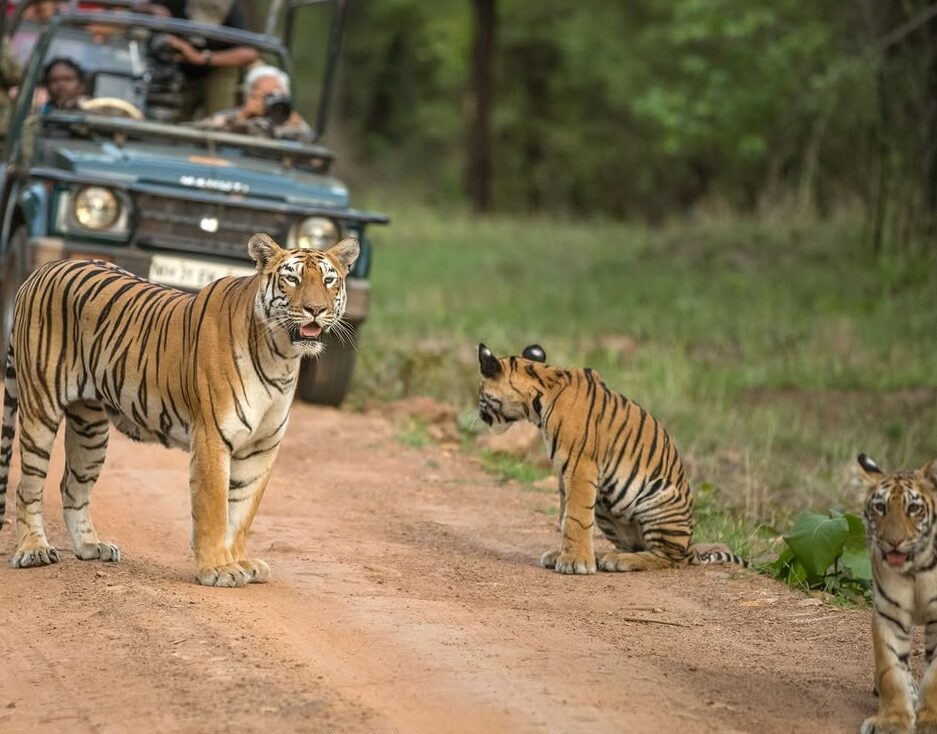India’s Safaris: More Mystery, More Thrill, More Wild!

While African safaris are known for their open savannahs and vast wildlife herds, Indian safaris offer a completely different kind of thrill—one that’s raw, intimate, and steeped in mystery.
An Indian safari isn’t just a ride through the jungle — it’s a real-life treasure hunt, where every rustle, call, and track could lead you to a wild surprise.
Unlike the wide-open grasslands of Africa, Indian jungles are dense, mysterious, and full of secrets. Here, spotting a tiger or leopard is like uncovering a hidden gem — a mix of sharp observation, expert tracking, and yes, a bit of jungle luck.
In India, you’re not scanning endless plains — you’re venturing deep into ancient jungles, thick with sal, teak, bamboo, and history. The silence here is broken only by alarm calls and distant bird calls.
🐾 Forest Signals: Decoding the Jungle’s Language on Indian Safaris
🔊 1. Alarm Calls: The Jungle’s Warning System
Animals like langurs, spotted deer (chital), and sambar deer & some birds let out sharp, specific calls when they sense a predator nearby.
- A langur’s high-pitched bark? Likely a leopard in the area.
- A sambar’s deep, single-note call? Possibly a tiger lurking.
Guides and drivers often stop the jeep and wait in silence — listening for the direction and urgency of these calls.
👣 2. Pug marks: Footprints of the Big Cats
Tigers and leopards leave distinct footprints (called pugmarks) in mud or soft dust.
- Fresh pugmarks mean the predator may be close.
- Size, stride length, and direction tell a story — is it a male tiger on patrol, or a female with cubs?
Expert trackers use pugmarks like maps through the forest.
🐒 3. Movement & Behaviour of Prey Animals
Sudden staring into bushes, stomping hooves, or frozen stillness among prey species often signals danger.
These silent cues are key to locating predators.
🐾 4. Droppings, Scratch Marks & Scent Sprays
- Territorial scent marks on trees (by tigers)
- Scratch marks on the bark or paths
- Scat (droppings) with fur or hooves — clues to recent kills
💧 Wild Signals from Waterbodies on Safari
Waterholes, rivers, and ponds in Indian forests aren’t just scenic—they’re natural stages where predator and prey cross paths, and where trackers find valuable clues:
🐾 1. Fresh Pug marks at the Edge
Tigers, leopards, sloth bears, and even wild dogs visit water sources regularly.
- Fresh pugmarks near the water’s edge (still sharp, undisturbed) often mean the animal drank or crossed minutes ago.
- Guides check for mud trails leading away, direction, and whether the cat is returning or moving deeper in.
🌊 2. Muddy Water or Ripples
Still water turning muddy, rippled, or recently disturbed (with wet footprints nearby) signals a recent visit—often a tiger taking a dip, especially in summer.
🐦 3. Bird Alarm Near Water
Waterbirds like egrets, lapwings, or herons suddenly flying off or giving alarm calls may indicate the presence of a stalking predator.
Even jungle fowl or peacocks near riverbeds will give sharp cries if danger is near.
🐾 4. Drag Marks & Kill Remains or Smell
Tigers often drag their kill to water sources to cool off while feeding or hydrate afterward.You may see drag marks, blood stains, or kill remnants or indicating a big cat may be close and resting nearby.
🐘 5. Elephant or Gaur Movement
Large animals like elephants or gaurs frequently visit waterholes. If they appear nervous, hesitant, or suddenly move away, it might indicate the scent or presence of a predator nearby.
Observing the surroundings can help safari experts predict tiger sightings, track leopards, or even identify hidden ambush spots.These signals help the guides to determine how recently a big cat passed through.
A Safari Full of Surprises and Stories
Spotting a tiger in the dense undergrowth or on a dusty trail is not just a sighting — it’s a moment of pure adrenaline, earned through patience and instinct.
Indian safaris are more than wildlife viewing — they are immersive jungle narratives, layered with biodiversity, tribal heritage, and legendary tales like The Jungle Book. You’re not chasing checklists — you’re uncovering secrets the forest chooses to share.
Because in the Indian jungle — you don’t just see wildlife, you search for it. And when you find it… the reward is unmatched.
From the elusive leopard of Satpura to the majestic tigers of Tadoba, every Indian safari is an intimate, story-driven adventure, often with fewer vehicles and a stronger sense of wilderness.
Why Choose WildTrails?
At WildTrails, our local guides bring deep knowledge of the jungle and understand animal behavior patterns like second nature. Paired with skilled drivers who expertly navigate forest routes and read pugmarks with precision, your safari isn’t just a ride — it’s a lifetime memory in the making.
“With WildTrails, you’re not just taking a safari — you’re stepping closer to nature, wildlife, and their untouched habitats, creating memories that will stay with you for a lifetime.”
Get ready — your wild journey awaits. See you on safari!”
👉 Click here to book your unforgettable safari adventure now!
With 4 years of Sightings data + Extensive expert tracker network in jungles, our customers had the best wildlife experiences.
Buy Wildlife Fashion Accessories
Exclusive Online Store for wildlife products
Packages
Packages Loading...
Recent Posts






